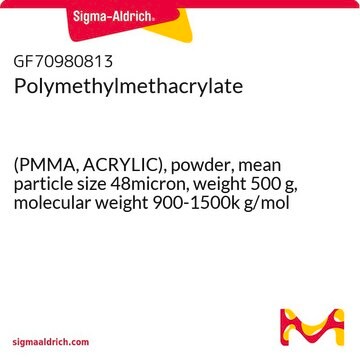03558
Poly(methylmethacrylat)
analytical standard, for GPC, 2,480,000
Synonym(e):
PMMA, Polymethacrylsäuremethylester
Anmeldenzur Ansicht organisationsspezifischer und vertraglich vereinbarter Preise
Alle Fotos(1)
About This Item
Lineare Formel:
[CH2C(CH3)(CO2CH3)]n
CAS-Nummer:
MDL-Nummer:
UNSPSC-Code:
41116107
PubChem Substanz-ID:
NACRES:
NA.24
Empfohlene Produkte
Qualität
analytical standard
for GPC
Qualitätsniveau
Selbstzündungstemp.
580 °F
Haltbarkeit
limited shelf life, expiry date on the label
Mol-Gew.
Mn ~2140000
Mp ~2740000
Mw ~2480000
Löslichkeit
H2O: insoluble
Dichte
1.200 g/cm3
Mw/Mn
~1.16
Lagertemp.
2-8°C
InChI
1S/C5H9O2/c1-4(2)5(6)7-3/h1-3H3
InChIKey
PMAMJWJDBDSDHV-UHFFFAOYSA-N
Suchen Sie nach ähnlichen Produkten? Aufrufen Leitfaden zum Produktvergleich
Verwandte Kategorien
Allgemeine Beschreibung
Poly(methyl methacrylate) is a material, which can be used in the fabrication of micro-fluid chips. It can also find applications in nano-transfer printing, since it can act like a macroscopic mediator in order to handle nanoscale building blocks.
Lagerklassenschlüssel
11 - Combustible Solids
WGK
nwg
Persönliche Schutzausrüstung
Eyeshields, Gloves, type N95 (US)
Choose from one of the most recent versions:
Besitzen Sie dieses Produkt bereits?
In der Dokumentenbibliothek finden Sie die Dokumentation zu den Produkten, die Sie kürzlich erworben haben.
Kunden haben sich ebenfalls angesehen
Creation of nanostructures with poly (methyl methacrylate)-mediated nanotransfer printing
Jiao L, et al.
Journal of the American Chemical Society, 130, 12612-12613 (2008)
Development and spectral characterization of poly (methyl methacrylate)/hydroxyapatite composite for biomedical applications
Chen Y, et al.
Development and spectral characterization of poly (methyl methacrylate)/hydroxyapatite composite for biomedical applications, 18(1), 41-45 (2004)
Bo Chen et al.
Journal of controlled release : official journal of the Controlled Release Society, 140(3), 203-209 (2009-05-26)
Water-soluble polymers for the delivery of chemotherapeutic drugs passively target solid tumors as a consequence of reduced renal clearance and the enhanced permeation and retention (EPR) effect. Elimination of the polymers in the kidney occurs due to filtration through biological
Taher Alizadeh et al.
Journal of hazardous materials, 248-249, 401-406 (2013-02-19)
It was demonstrated that a thin film of chemically exfoliated graphene flakes, blended with poly(methyl methacrylate), could be used as a chemiresistor sensor for the sensitive and selective determination of formaldehyde vapor. Formaldehyde adsorption on the sensing film led to
Jose-Luis Ruiz
Journal of the Massachusetts Dental Society, 61(2), 16-19 (2013-03-22)
The literature is replete with articles arguing which is the next best restorative material to substitute porcelain fused to metal (PFM) crowns. Sadly, most of the discussion is about the strength and cost of the materials and often not about
Unser Team von Wissenschaftlern verfügt über Erfahrung in allen Forschungsbereichen einschließlich Life Science, Materialwissenschaften, chemischer Synthese, Chromatographie, Analytik und vielen mehr..
Setzen Sie sich mit dem technischen Dienst in Verbindung.


